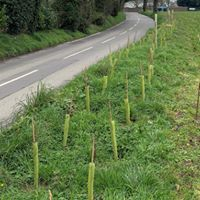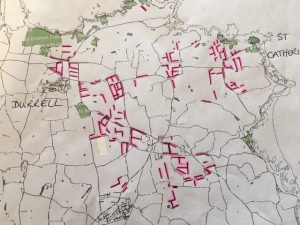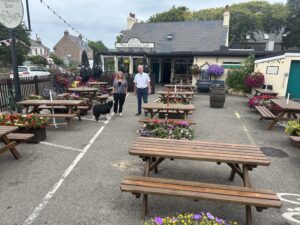
But arboreal, not financial – Donna Le Marrec of the National Trust for Jersey explains why they are ‘tying a yellow ribbon round that old oak tree’
FOLLOWING the planting of 20,000 hedging whips late last year, the National Trust for Jersey is working hard to ensure their survival through active management as well as the erection of yellow markers.
In a large area between Jersey Zoo and Rozel, wooden marker posts measuring two metres in height with bright yellow painted tops, have started to appear miraculously in the vegetation. Supplied by the Acorn Woodshack, the posts have been placed at the start and ends of the new hedgerows. In addition, bamboos with yellow ribbons are also being used in strategic places to further highlight the planting, thereby warning flail operators undertaking the branchage of to the presence of the new hedging.
In addition cutting and clearing the surrounding vegetation around the newly planted hedging is under way. This task is vital as tall weeds such as hogweed and bracken, if left to grow to full height, can starve the hedging of light and when they die off at the end of the summer they can collapse, bringing the surrounding small hedging plants down with them.
When the current movement and working restrictions are relaxed the National Trust will be looking to recruit volunteers and workers from the corporate sector.
‘Their help will be instrumental to the success of this project and ensure a high survival rate,’ said Conrad Evans, Hedge Fund coordinator. ‘The project benefited from volunteer and corporate assistance with the planting in the winter so there is an ideal opportunity for them to return in order to see the whips grow and develop into significant and useful hedges.’
The Jersey Royal Company, who rent the land and is partnering with the Trust on the hedge planting project, has compiled a detailed planting map to give to those staff who are responsible for maintaining the boundaries.
The new branchage guidelines should also mean there is less chance of accidental damage in the future. Those who manage field boundaries are now encouraged to only cut the relevant areas like the sides and leave the tops of the banks that will allow more wild flowering plants to survive and set seed. ‘This will prove to be a real boost for bio-diversity and also help our pollinating insects as well as numerous other types of fauna in the Island,’ he said.





